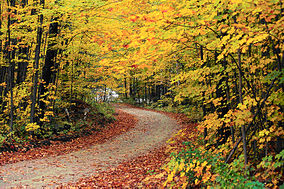Green Mountain National Forest
| Green Mountain National Forest | |
|---|---|
|
IUCN category VI (protected area with sustainable use of natural resources)
|
|
 |
|
| Location | Vermont, United States |
| Nearest city | Rutland |
| Coordinates | 43°57′N 73°04′W / 43.950°N 73.067°WCoordinates: 43°57′N 73°04′W / 43.950°N 73.067°W |
| Area | 399,151 acres (1,615.31 km2) |
| Established | April 25, 1932 |
| Governing body | U.S. Forest Service |
| Website | Green Mountain & Finger Lakes National Forests |
Green Mountain National Forest is a national forest located in Vermont, a forest area typical of the New England/Acadian forests ecoregion. The forest supports a variety of wildlife, including beaver, moose, coyote, black bear, and white tailed deer. It also supports an abundant variety of bird species, such as wild turkey and ruffed grouse. The forest, being situated in Vermont's Green Mountains, has been referred to as the 'granite backbone' of the state.
The forest was established in 1932, as a result of uncontrolled overlogging, fire and flooding. It consists of 399,151 acres (1,615.31 km2); and is the biggest contiguous land mass in the state. If Finger Lakes National Forest, which is managed as a unit of the Green Mountain National Forest, is included within it, GMNF is one of only two national forest northeast of the Pennsylvania-New Jersey barrier; the other being the White Mountain National Forest. Split into the southwest and central areas, GMNF has a total of eight wilderness areas. These were designated by Congress beginning with the Wilderness Act of 1964 to be areas off limits to mechanized gear down to and including bicycles.
In descending order of land area it is located in parts of Bennington, Addison, Rutland, Windham, Windsor, and Washington counties. The forest headquarters are in Rutland, Vermont, alongside those of Finger Lakes National Forest in New York.
...
Wikipedia

